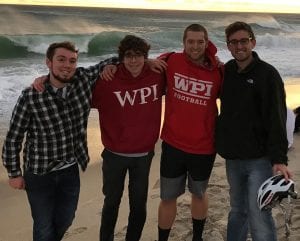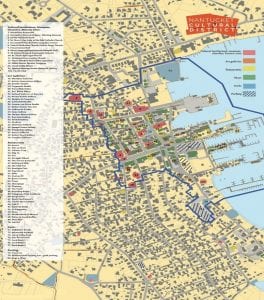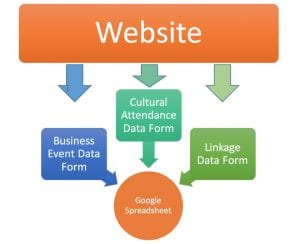Strengthening the Nantucket Cultural District: Community Outreach and Data Collection
| Sponsor: | Nantucket Cultural District Executive Steering Committee |  |
| Sponsor Liaison: | Virna Gonzalez, Melissa Murphy, Janet Schulte | |
| Student Team: | Joseph Berger, Christopher Mayforth, Jonathan Metzger, Jacob Moon | |
| Abstract: |
The Nantucket Cultural District (NCD) was officially designated in January 2016 with the goal to centralize, expand, and promote the island’s culture. This project’s goals were to assist the NCD by developing a community outreach plan and by creating a system to collect and evaluate metrics to measure the impacts of the district. To realize the first goal, we developed a website to centralize social and district media. To achieve our second goal, we utilized Google Forms and Google Sheets to develop a data collection and analysis tool. Finally, we made recommendations to the NCD to expand district membership, broaden web presence, increase metric tracking, and adopt a new sustainable financial model.
|
|
| Link: |
Final Report: wpi-nantucket-cultural-district-final-report Presentation: ack16ncd-final-presentation-pptx |
|
Executive Summary
Introduction
The Nantucket Cultural District (NCD) was officially designated in January 2016. The district was formed with the goal to centralize and expand the culture of the island and to advertise to residents and tourists the different aspects of the island culture. However, since the district is so new, many advancement strategies are still in the development stage. Central to these advancement strategies are the development of “linkages”, or strategic marketing partnerships between businesses and cultural organizations within the district. As such, certain metrics need to be developed, collected, and analyzed by the district in order to show the economic and other impacts of linkages as well as the overall success of the district.
Figure 1: Map of the Nantucket Cultural District
Background
A cultural district can be defined as a walkable area comprised of businesses and cultural organizations. The development of cultural districts is often considered when vacant and unused infrastructure leads to low property values, crime, and a lack of a sense of community. Such areas can be repurposed by local government as “fertile grounds for redevelopment” (Cultural Districts, 2012), which can then be expanded upon by the community to include business development zones, artist areas, and cultural districts, among many other redevelopment spaces.
Cultural districts can either form naturally, or a municipality may choose to pursue a specific district type in order to adapt to a city’s needs and goals. Cities that seek the formation of cultural districts understand that community, diversity, and heritage are essential tools for the holistic and long-term development of an area. (Duxbury, et. al. 2016).
Cultural districts have proven to increase out of town tourism, foot traffic, time, and money spent in a particular area. For example, a 2013 analysis of 99 different cultural districts throughout the United States showed that in general, there are notable positive effects of district formation on property values, employment levels, and income levels both within the districts, as well as areas within close proximity to the district (Noonan 2013).
Cultural districts can also have a major role in organizing both small and large-scale events that involve collaborations between stakeholders in the district. Annual events such as food, art, and film festivals, concert series, and holiday celebrations are all proven to be much more effective at being economically successful when cultural organizations work together, as opposed to operating independently (Thornton, 2012)
While cultural districts are known to have a wide range of advantages, there are additional notable considerations. In particular, when cultural districts are designed to be used as a public policy instrument for local economies or for urban revitalization reasons, there can be negative socioeconomic consequences (Thornton, 2012). These consequences can include gentrification, the “Disneyfication” of an area, and the unfortunate reality that some efforts will not achieve sustained success.
Methodology
Our goal was to assist the Nantucket Cultural District by developing a community outreach plan and creating a system to collect and evaluate metrics to measure the impacts of the district.
Our sponsors suggested we start by communicating with specific stakeholders involved in the cultural district through interviews, focus groups, and surveys. Our first step then was to collect qualitative data from cultural organizations, businesses, and residents by interviewing key stakeholders. The goal of these interviews was to determine key stakeholder knowledge of the cultural district as well as their willingness to cooperate with the NCD.
Our second step was to create an initial list of possible metrics based on our study of other cultural districts. We then created a set of criteria to determine if the proposed metrics would be applicable to the NCD and based our methods for selecting quantitative metrics on the following criteria:
- Non-disclosure of sensitive business data
- Data already collected or easily collected by member organizations
- Metric representative of economic impacts
- Realistic for the NCD to collect from member organization
Results
Interview Findings
Listed below are the most important findings from our interviews. A complete list of findings can be found in our report.
- Many community members do not know about the cultural district or its purpose.
- Community members use social media for obtaining and relaying information about events that occur on the island and in the district.
- Businesses generally only track inventory and sales data, while nonprofit organizations track attendance data.
- Businesses were not likely to share their total gross sales, but they would likely share percentage changes in gross sales if they were asked and the data was kept anonymous.
Website and Social Media Plan
One of the Nantucket Cultural District’s primary goals was to increase awareness of the cultural district. We determined that since the Steering Committee had already developed physical media such as maps and brochures, the next logical step was to develop an increased internet presence. At the start of the project, the district’s web presence was limited to a single page on the Town of Nantucket Department of Culture and Tourism website. We proposed to the NCD Executive Steering Committee that we expand the current internet presence into a fully-featured, independent website (URL: www.nantucketculturaldistrict.org).
The website went through multiple drafts over the course of its development. This included the use of a focus group with the Steering Committee members providing feedback and discussion, which resulted in a variety of feature changes. While developing the website, we determined that the website should have a dual-role as an educational tool for visitors as well as a platform for businesses and cultural organizations to communicate and collaborate with one another, as well as access the data submittal tool that our team developed.
Creating a Data Collection and Analysis Tool
In order to develop our data collection and analysis tool we created a list of criteria of the necessary features that can be found in our full report. A list of our most important criteria are included below:
- An easy-use tool that required minimal training
- Able to collect and consolidate confidential data from many different sources
- Enable easy analysis of data, including economic changes in correlation with cultural district events
- Track linkages and collaborations between organizations
Based on these criteria, we chose to use Google Forms and Google Sheets for a data collection tool. Google Forms is a software program that allows the user to create a questionnaire that can be sent to multiple people and allows the answers to be automatically archived in Google Sheets. Google Sheets is a software application similar to Microsoft Excel that allows the user to archive and analyze information as well as create graphical representations of data. The data collection process is displayed in Figure 2. The process starts at the website, where cultural organizations and businesses can access the data collection forms. Using the Google Form interface, the data is submitted and automatically uploaded to Google Sheets where it is archived and analyzed.
For businesses, the Google Form is structured to collect percentage change in gross sales from three days, each one exactly a week apart. For example, each participating business would be asked for their percentage change sales data from the Thursday prior to a selected event, the day of the event, and the Thursday after the event. Due to the potential ambiguity of the data we are trying to collect from businesses, we created a Percentage Change Calculator. This is a simple Excel formula sheet which takes in the date of the event, gross sales for three days, and returns a consistent percentage change. This ensures all data submitted using the data collection forms accurately reflects the data we are trying to collect.
For the cultural organization members of the district, the NCD Steering Committee has requested that they submit data to the NCD on attendance numbers so that the NCD could, in turn, aggregate the attendance data and submit it to the Massachusetts Cultural Council as part of their state-required annual report. Prior to our arrival, the cultural organizations did not have a uniform way to submit attendance data. To address this issue, we developed another Google Form for that purpose. The cultural organizations are to select two events to report attendance data, one during the on-season and one during the off-season for data collection, so we incorporated this requirement into the form.
Finally, in addition to the Business Event Data and the Cultural Attendance Data, we also set up a Google Form to collect information regarding linkages (collaborations) between businesses and cultural organizations. This form collects information such as the name of the linkage, the date it occurred, general reception, the weather, and their change in gross sales before and after the event.
Figure 2: This figure shows how the data collection and archiving process takes place.
Recommendations
Our project resulted in six recommendations we identified as important that the NCD address. They are sorted by importance, starting with what we believe is the most important and immediate recommendation.
- The NCD should improve public knowledge and support of the NCD by inviting new members of the residential, business, and seasonal communities to join the district.
Working with the NCD Executive Steering Committee, we assisted in the development of a short guide on how the NCD should approach new potential members of the district, as well as what specifically should qualify a new business or organization to be considered a member for the district. If more businesses and organizations participate in the data collection process, the data that is collected to assess the impact of the cultural district events will be more comprehensive and useful.
- The NCD should collect data from for-profit businesses using our data collection system integrated into the new website.
In order to demonstrate the economic impacts of events in the district the NCD should collect non-sensitive business sales data. Data collection should begin as soon as possible, as it gives more time for businesses and organizations to find time to compile and submit their data. This process should be facilitated between the owners of the member organizations and the Steering Committee members. By fulfilling this recommendation, the NCD will be able to develop a more comprehensive annual report for the Massachusetts Cultural Council.
- The NCD should designate someone specifically to manage and update the cultural district website as needed to keep it current and useful.
Our third recommendation is that the Nantucket Cultural District designate someone specifically to update the website as needed to keep it current and useful. This should be completed as soon as possible so that the website is ready-to-use before the spring shoulder season begins.
- The NCD should expand their current social media presence to include more platforms as well as post more frequently to increase outreach and public knowledge of the district and cultural events.
The most important social media for the NCD to utilize is Facebook. We recommend the NCD additionally create profiles on Instagram and Twitter, but refrain from using YouTube, Reddit, Pinterest, or other social media sites as they are not suitable for the NCDs purposes. The use of social media will increase the knowledge and interest in the district as well as develop a platform for advertising. This should be completed as soon as possible so that the district and district events receive a maximum amount of exposure before the shoulder season begins in the spring.
- The NCD Steering Committee should adopt a sustainable financial model.
The NCD currently utilizes a financial model based on seeking grants from outside organizations such as ReMain Nantucket and the Massachusetts Cultural Council. Grants are not always a sustainable financial model, so the Steering Committee should look into additional funding models to sustain the district in the long run.
- The NCD should begin to track additional metrics pertinent to the district and grant applications.
To assist the NCD in seeking additional financial support using additional cultural district metrics not necessarily required by the Massachusetts Cultural Council, we have compiled a list of potential metrics from a variety of sources (other districts, grant-giving organization, etc.) to give the NCD a foundation of metrics they should look into tracking in the future.
Bibliography
Duxbury, N., Hosagrahar, J., Pascual Jyoth., (2016). Why must culture be at the heart of sustainable urban development? UCLG.
Thornton, S. (2012). Cultural districts and the potential for urban development. Advocate’s Forum, (2012), 41-51. Retrieved September 08, 2016, from http://ssa.uchicago.edu/sites/default/files/uploads/AdvocatesForum_2012_web_1.pdf
Noonan, D. S. (2013). How US cultural districts reshape neighbourhoods. Cultural Trends, 22(3-4), 203-212. Retrieved September 11, 2016, from https://www.arts.gov/sites/default/files/Research-Art-Works-GeorgiaTech.pdf




